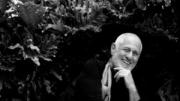Some of the most creative, productive people in the world—such as businessman and scientist Jack Dangermond, M.L.A. ’69, and MIT Media Lab founder Nicholas Negroponte—“were trained in architecture and urban design” but went on to achieve greatness in other fields, noted TED conference founder Richard Saul Wurman during his Class Day speech at the Graduate School of Design (GSD) on May 29.
Wurman added himself to that list. A University of Pennsylvania-trained architect, he said he practiced for 13 years before “going bankrupt, belly up” at age 45—and moving on to chair the TED conference. From 1984 through 2002, he connected many of the world’s most radical thinkers for inspiring, provocative conversations that produced fresh ideas. (One session from 2002 features Wurman and his friend, architect Frank Gehry, Ds ’57, Ar.D. ’00, who has taught at Harvard).
“I haven’t done architecture in a long time,” continued Wurman, now 78. “But I’ve done 40 conferences, written some 80 books, [whose topics range from football to health care to city guides,] and now have quite enough money. I’m doing OK.” His work has earned multiple honors over the years, including the Smithsonian Institution’s Lifetime Achievement Award in 2012. This “interesting life,” he said, is due to a solid education and “learning experience with architecture, and particularly with Louis Kahn, who remains my mentor. The only people who didn’t fire me in life were Lou Kahn and Charles Eames. So I’m a little abrasive, I guess.”
An education in design, Wurman explained, offers a foundational “way of thinking about the world.” It enables students to make abstract connections, see patterns among diverse disciplines, and use information in novel ways.
Before launching into his loosely improvised talk (given without notes or prompts while roaming the GSD’s Piper Auditorium), Wurman commented that the auditorium should have had more divisions among the seats and aisles to equalize the audience’s experience; he also shunned the podium at the front because, he said, it had been wrongly placed to the far right. “Why was it put there? Are the people on that side more important than those on the other?” he queried: these questions—of experience, of place and purpose, of intention and result—“are the things you need to think about: everything is design.” A man who makes known what he wants, Wurman also nixed a student’s planned introduction to his talk and had all the audience members get up and move to seats closer to the front. “You should rush to the front rows and not sit in back so you can leave,” he said. “You should assert yourselves in listening. Listen to what people say and see if you can make the connective tissue work.” And, by the way, he added, he would not be at all offended if anyone got up and left: “I’m not interested in most of the [stuff] I hear people say. I find it really boring.”
He went on to emphasize the need for people to “look for the opposites.” He reported loving television and has “two machines” at his home in Newport, Rhode Island, that record 140 hours of, typically, documentary programming that he watches at night “in fast-forward mode.” Lately, he’s been learning about the Black Plague. It decimated half the population: it was horrible. But, Wurman asked, “what about the other 50 percent—the people who lived. Why did they live? What did they do? Nobody tells you about that. It’s the 50 percent who are alive that are interesting.” That period in history, he pointed out, ultimately led to an era of inventiveness, and the Renaissance. It’s interesting to examine what appears to be explained or understood—but isn’t, he added, “and to look at the patterns that make change,” often for surprising, unexamined reasons. This is the work of designers and architects. “Think about flipping everything you have in your mind,” he asserted. “Seeing new connections gives me the courage to challenge what everybody is telling me—because it could be wrong.”
Wurman was once described by Fortune magazine as an “intellectual hedonist with a hummingbird mind.” Last September, he unveiled his latest creation: the WWW.WWW Conference, “a celebration of improvised conversation,” that took place in Redlands, California (where Jack Dangermond lives). Wurman eliminated the usual style of “presentations” and background screens (in favor of a concrete wall), and had the subjects face each other, instead of the audience.
Two physicists, for example, talked about how they define the word “elegance,” and see the periodic table differently. “They don’t talk the same language—then they talked. It was all intellectual jazz. Improvised conversation,” Wurman told the GSD audience. “And they talked as long as it was interesting; then I said, ‘Get off.’ (Not quite as nice as that.)” Wurman’s talk had the same ad hoc flavor. And he didn’t take questions from the audience at the end. “They come in two varieties: bad questions and speeches,” he explained. “I know that’s very un-PC, but that’s the way it is. It’s hard to ask good questions.” No one is taught how to do it, or how to have conversations, he asserted. “Do you know how lousy most phone calls are?”—and yet they “form the fabric of our lives.” And these exchanges, where we “assert our listening,” are critical because “architects don’t build buildings, landscape architects don’t plant trees, planners don’t build roads,” he pointed out. “They give instructions to others on how to do that—and they gather information about what to do by asking good questions and having conversations.”









